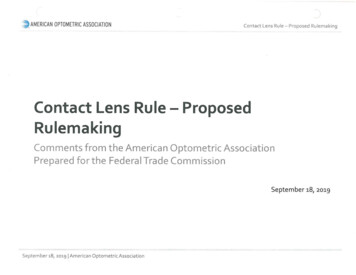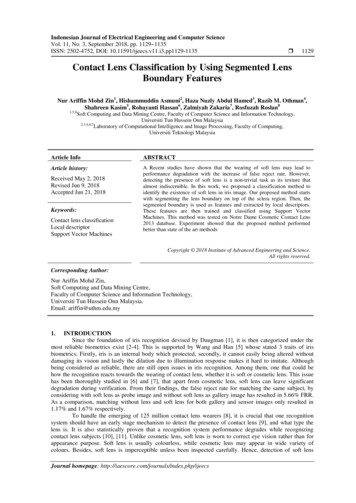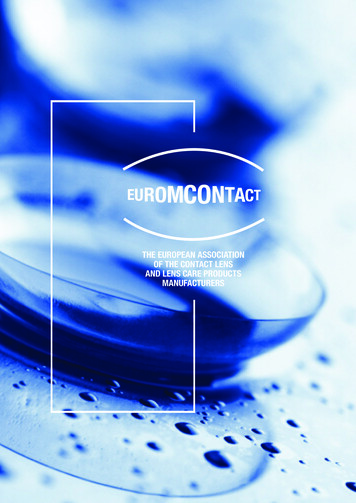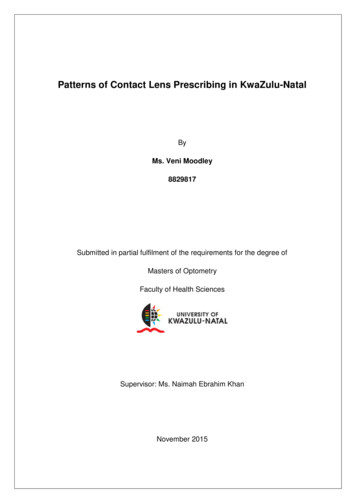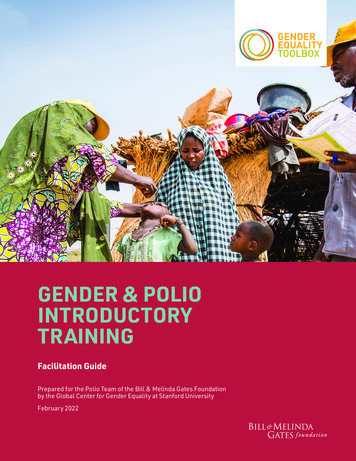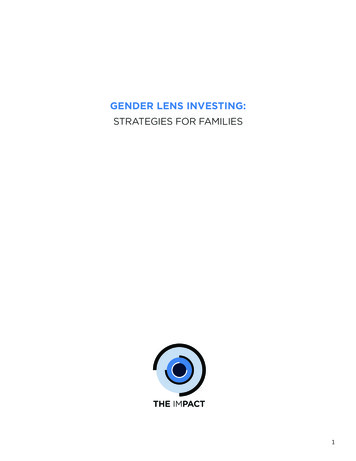
Transcription
GENDER LENS INVESTING:STRATEGIES FOR FAMILIES1
The ImPact is a membership network of family enterprises (family offices,foundations, and businesses) that are committed to making investments withmeasurable social impact. The ImPact provides families with the knowledge andnetwork they need to make more impact investments more effectively, and usessophisticated technology for data aggregation, analysis, and reporting to shift thenarrative of impact investing from one of inputs (dollars committed) to outcomes(impact created). Our purpose is to improve the probability and pace of solvingsocial problems by increasing the flow of capital to investments generatingmeasurable social impact.The information provided in this document is for informational purposes only anddoes not constitute a solicitation, offer or sale of securities. Neither the investmentexamples cited, nor the ImPact’s mention of examples, constitutes investment adviceor a recommendation to purchase or sell any securities. The ImPact is not, and does notprovide services as an investment advisor, investment analyst, broker, dealer, marketmaker, investment banker or underwriter. The ImPact does not receive any compensationor fee for citing investment examples in this document or any consideration as a result ofany discussion or transaction with respect to any such investments. MARCH 2018 The ImPact2
GENDER LENS INVESTING:STRATEGIES FOR FAMILIESThis piece offers succinct, actionable insights for families interested in investing with a gender lens.Over a dozen interviews with gender lens investors provided wisdom for this publication abouthow and why families use gender as a factor of analysis in their investment decisions. Readers canuse their experiences and stories to understand and seize the diverse opportunities for consideringgender in investment decision-making. This report offers information for families at all startingpoints, ranging from families who want to use a gender lens to spot potential opportunities formarket outperformance, families who want to use gender as the central focus of their investmentthesis, and those who want to blend it into an existing impact strategy.Gender matters ininvestment decisionsGender shapes the world around us.Gender influences the way people live theirlives, the way they understand themselves,and the opportunities available to them.In one way or another, every enterprise —and every investment — is impacted bygender, whether it be through the genderof those in leadership and governancepositions, how employees experienceworkplace policies and practices, howproducts and services are designed andmarketed to women, or how women aretreated throughout the supply chain.Gender lens investors incorporate genderanalysis into their investment decision-making because they believe it canhelp improve financial returns, reduceinvestment risk, or generate specific socialdividends.A growing body of evidence connectsgender to the life of companies. Accordingto a 2015 McKinsey report that examined366 public companies, those in the topquartile for gender diversity were 15percent more likely to have financialreturns above their respective nationalindustry means.1 Women in the UnitedStates reportedly control 73 percent ofall household spending. Consumer goodscompanies that do not consider a femalepoint of view in their product design,marketing, and product use will likelymiss significant opportunities.2 And newdata shows that sexual and gender-basedviolence may present a material risk tocompanies and industries.3All asset owners can consider gender intheir investment decision-making, andmany already do. Many investors whoconsider gender as a necessary factor ofanalysis in their investments already caredeeply about the issue of gender equity;and an increasing number of investors seethe business case for gender lens investing.What is gender lens investing?At their core, gender lens investorsrecognize the ubiquity of gendered patternsin our world and use gender analysis tosharpen their understanding of investableopportunities. Just as a camera lens canhelp focus an image for the photographer,a gender lens can shed new light on aninvestment opportunity or strategy.Individuals use different lenses to see thesame object in number of ways; a macrolens shows the tiniest of details thatmake up the subject, whereas a telephoto3
lens sharpens a subject that is far away.Similarly, investors can use a diverse setof gender lenses to address a diverse set ofgender issues and to examine investmentopportunities with a new perspective.Where one investor may want tounderstand the gender balance of seniorleadership in the public companies in whichthey are invested, another may prioritizeinvestment in companies developingproducts and services for women. Similarly,while one family may use their venturephilanthropy to address discriminationagainst genderqueer4 people, anothermay seek to invest in companies that helpdisrupt gender stereotyping. Each of theseapproaches is a distinct gender lens.If you are new to this topic you mightask, “What steps can I take right nowto incorporate a gender lens into myinvestment portfolio?” Perhaps you are aveteran investor and you wonder “Howcan I increase the sophistication of myapproach and deepen my gender lensinvesting activity?”Over and over, experienced gender lensinvestors relay that their best adviceis to take action and iterate based onreal-life experience. Most of the familiesinterviewed for this publication did nothave a comprehensive strategy beforethey first took action; they began byasking questions, taking a few steps in onedirection, assessing their progress, andadjusting. The particular actions familiestake depend on their motivations. Theirmotivations will lead in turn to differentobjectives. And families must also considertheir investment constraints, such as risktolerance and liquidity needs. A family’scapability to execute a gender lens investingstrategy will also depend on the support oftheir advisors and fund managers.This primer explores three different genderlenses:LENS 1: Examine gender equity in theworkplace or value chain of specificcompanies.LENS 2: Invest in products andservices for women, especially whenand where women are an underservedmarket.LENS 3: Invest to address thesystematic exclusion or exploitationof women.What follows is an exploration of eightspecific actions within three widely-usedgender lenses that families can take toadd or sharpen a gender lens on theirinvestment portfolio.Development and Implementation of a Gender Lens Investment StrategyThe development and implementation of a gender lens investment strategy is amulti-step, iterative process:Step 1: Reflect to understand your own motivations, objectives, needs, andconstraints.Step 2: Ask questions of those in whom you invest, or the people you entrust tomanage your money.Step 3: Start to allocate capital.Step 4: Continually iterate and refine your gender lens investing strategy based onlessons learned from investments.4
Put Your Gender Lens in Writing“We were able to set up a separately-managed account in which the investments adhered to five genderrelated guidelines ” —Sallie Beck at Embrey Family FoundationAs part of their efforts in the mission related investingspace, the Embrey Family Foundation engaged theSocially Innovative Investing Team at U.S. Trust (S2I)to develop a series of custom portfolio selectioncriteria that reflected the values and mission of thefamily and the leadership of the organization. TheEmbrey Family Foundation had a separately managedaccount with the U.S. Trust team, which enabled themto implement those guidelines across asset classes.The guidelines included:1. S eeking companies that are thoughtfully engagingwomen as an economic force and improving thequality of products and services delivered towomen.2. I nvesting where companies have an articulatedpolicy on not deploying indentured and / orslave labor and investing in corporations with aproactive approach to women as employees and aspart of the corporate supply chain.3. F avoring companies that have fair and ethical paypractices rooted in equality, that are recognizedas good places to work, especially for women andgirls, and that portray women and girls in a positivelight.4. I dentifying corporations that have a forwardthinking approach to women in leadership andmanagement positions, including those at theboard level.5. Selecting companies that are thoughtful andconsistent on human capital managementpractices, environmental stewardship andsustainability principles, and are consistent ornatural on community engagement and corporatephilanthropy.6. Excluding weapons, tobacco, pornography, gamingand pharma companies developing or distributingmood-enhancing drugs.5
LENS1 “We’re lookingfor an all-starmanagement teamwith the rightexperience, passion,commitment,resumes, andcredentials.We never had aninstitutional policyto favor femalefounders or CEOs—but when we wentback and counted,we saw 50 percentfemale founders inour PRI portfolio.”—Meredith Shields6Examine gender equity in theworkplace or value chain ofspecific companies.Families who want to promote womenin leadership, ensure safe and successfulworkplaces for people of any gender identification, or help women entrepreneurs gainaccess to investment capital can focus theirgender lenses on analyzing the leadershipand policies of specific companies. Beloware three common actions families can taketo build or sharpen the gender lens analysisof a specific enterprise.Action 1. Analyze your existing portfoliocompanies for: the gender balance ofemployees and leadership teams, thetreatment of women in the supply chain,and workplace policies.An important early step in developinga gender lens investing strategy is to“know what you own.” Families can workwith their advisors and fund managersto analyze their existing holdings with agender lens.Families can begin by analyzing the genderdiversity in the leadership of companiesin their portfolio across asset classes.By doing this inspection, families maydiscover some investments run counterto their values — in other cases theymay be pleasantly surprised. MeredithShields, Managing Director of SorensonImpact Foundation, explained that theFoundation recently conducted a review oftheir existing program-related investmentportfolio5 using a gender lens. While theydid not specifically target female foundersor enterprises seeking to serve womenwhen making these investments, theyfound that their portfolio had 50 percentfemale-led or female-founded companies.In the United States, where femalefounders get only 2 percent6 of all venturecapital dollars, having an early stageportfolio with 50 percent female foundersis extraordinary. For the Sorenson ImpactFoundation, uncovering this trend hasinspired them to track several gender-specific attributes that they can potentially usein future decision-making processes.Other families seek to create safe, wellpaying jobs for women by analyzing thedemographic makeup of a company’sworkforce.Ingrid Stange, for example, invested in theSahara Forest Project, where the majorityof employees are women. In a region ofthe world where stable, safe, and well-paidemployment for women can be rare, partof Ingrid’s decision-making process considered employment of women as a criticalfactor. Ingrid blends her gender lens withanother impact focus: addressing resourcescarcity in regions of the world where alack of fresh water and clean energy posea threat to society. Sahara Forest Projectfits squarely into her strategy because it isa technology and infrastructure companythat utilizes desert, sunlight, saltwater,and CO2 to produce food, water, and cleanenergy — and offers stable employmentfor women. Ingrid sees this investment asa triple win: addressing resource scarcity,safe and stable employment opportunitiesfor women, and financial return on herinvestment.To dive deeper into the culture andinternal workings of a specific company,families can examine its workplace policiessurrounding diversity and inclusion, familyleave, and pay equity. Sometimes, by askingcompany leadership about their policy ongender diversity and inclusion, an investorcan encourage management to pay moreattention to gender equality. And in time,it may spur a change in the mindset andworkplace policies of that company.
Action 2. Screen out companieswith poor gender diversity records;proactively invest in funds or enterprisesthat promote women in leadership andexhibit best practices in gender sensitiveemployment policies.With the help of their advisor, somefamilies set up a gender diversity screen fortheir public equity portfolio that minimizestheir exposure to companies with poorgender diversity records. Some families seethis as a way to reduce long-term risk andvolatility, or to align their portfolio withtheir values. Companies with poor genderdiversity records might lack diversity andinclusion policies all together, have a poorworkplace safety record, or have a historyof sexual harassment controversies7.Other gender lens investors proactivelyinvest in public equity or public debtfunds that identify companies exhibiting best-in-class practices for womenin leadership. Investing with a focuson best-in-class practices for women inleadership has become easier for investorsin the past ten years as fund managershave developed more products to meetinvestor demand. The number of publicequity funds composed of securities usingwomen-in-leadership as a leading investment criterion has grown exponentiallyover that period.8 Over time, EmbreyFamily Foundation, for example, hasinvested part of its investment portfolioin the Women and Girls Equality Strategyfrom U.S. Trust, Nia Global Solutions, andthe Parity Portfolio from Morgan Stanley.Action 3. Invest directly in — or helpbuild the pipeline for — female-founded,female-led companies or funds.For families who have a portfolio of directinvestments, some consider investing infemale-founded, female-led companies orfunds. Families seek out opportunities toinvest with women-founded or women-ledcompanies because they see undervaluedbusiness ideas and talented entrepreneurswho might have been overlooked by otherearly-stage funders. Some families specifically want to promote women in leadership;still others want to increase the capitalallocated to female entrepreneurs.For Yann Borgstedt, it was a combinationof all three. Yann invested in leseclaireuses.com because he saw the outsized financialpotential of the company’s business planand two female entrepreneurs well positioned to implement it. The foundersof the fashion website now receive overfive million users per month and planto distribute 10 percent of all profits tocharities that support women.Other families layer impact strategiestogether with a preference for femaleentrepreneurs. One experienced genderlens investor wants to invest in companiesand funds that are addressing theSustainable Development Goals (SDGs).She also applies a gender lens focusedon allocating capital to women entrepreneurs. One example of this investor’s“layered” approach is her investment inApolitical: a women-founded, women-ledglobal network for government employees,helping public servants find the ideas,people, and partners they need to addressintractable social issues. “This is primarilyabout creatinggood, stable, andwell-paying jobsfor women.”—Ingrid StangeApolitical fits this investor’s gender lensand aligns with SDG16 (peace, justice, andstrong institutions). Internally, Apoliticalpromotes women in leadership and has twowomen co-founders. The founding teamremains committed to a company cultureconducive to and actively fostering genderparity, especially in areas where womenare traditionally underrepresented, suchas engineering. Externally, Apolitical seeksout specific policy content focused onwomen and girls as part of their Women’sEmpowerment global policy topic.7
2LENSInvest in products and services forwomen, especially when and wherewomen are an underserved market.Some investors see women as an underserved market in certain geographies andsectors. Those investors use a gender lens tofinance goods and services that can improvethe lives of women and girls. Oftentimesthese same gender lens investors seek tooutperform competitors in the marketplacethat might have overlooked the opportunityto focus on women as consumers. Below aretwo actions that families can take to investin products and services for women.Analyze where investors or businessleaders have missed or misunderstood theimportance of using a gender lens in theirproduct creation, design, and marketingstrategies.In many countries around the world,women are an underserved market. Despiteevidence that women make the vastmajority of consumer decisions worldwide,companies and corporations do not alwaysconsider a female viewpoint in their productcreation, design, marketing, or distributionstrategies.9 Some families analyze an investment opportunity by asking whether thecompany leadership has considered womenas consumers in their business plan.Sorenson Impact Foundation, for example,made a private equity investment intoKasha, a Kenyan-based e-commercecompany. Kasha offers women access topersonal care products, such as menstrualproducts and contraception. Sorenson’sinvestment committee saw significantmarket potential in an e-commerceplatform designed wholly for women. Inconducting further research into the sector,the Sorenson team was disturbed by thestatistics around the number of girls whomiss school due to lack of proper hygieneproducts, and saw the potential impact thecompany could have by reducing culturalstigmas around purchasing female menstrualand health products.10 The Sorenson teamlooked at several businesses and nonprofitsworking to address this issue and foundthat Kasha had the best team and businessmodel; Sorenson came in as the largestsingle investor.Action 5. Invest in funds or enterprises thatfocus on products or services for womenand girls.Some families use their gender lens to analyzehow a specific investment could improve thelives of women and girls. Kristin Hull, forexample, worked with Root Capital to createRoot Capital’s Women in Agriculture Initiative.Through the Women in Agriculture Initiative,Root Capital lends to businesses in parts ofthe agriculture industry that traditionallyemploy significant numbers of women, suchas staple food products, agro-processing, andwild-harvested crops. Root Capital screens forwomen in positions of leadership, looks forbusinesses where women make up more than30 percent of the employee population, andconfirms that businesses have explicit policiesand programs that benefit women.When Kristin initially spoke with Root Capital,they had no such gender lens, but with her andothers’ encouragement, they developed one.In turn, the Women in Agriculture Initiativeenabled Root Capital to seek investment fromgender lens investors who previously had notconsidered Root Capital.8
3LENSDeploy investment capitalto address issue areas wherewomen and girls are excluded orexploited.Some families focus their gender lensinvestment strategy on a specific genderissue where women and girls are systematically disadvantaged. Below are three actionsthat can help families build or clarify agender lens focused on problem-solving.Action 6. Invest directly in initiatives,funds, or companies that address theexclusion or exploitation of women.Gender lens investors who want to usetheir capital to address the disadvantageousposition of women in a particular marketsegment or geographic area, recognize thatthese issues are complex. Building a comprehensive approach takes time and experience.Families can begin by identifying an issuearea of importance, and then make a limitednumber of targeted investments to addressthat issue. From the experience of those firstinvestments, a family can learn and iteratetheir strategy as they better understand thelandscape of challenges and opportunities.Through her family office, Stardust, MollyGochman has taken this approach. Stardustinvests to accelerate the economic participation of people exploited and excluded bylabor markets.abuse in corporate supply chains worldwide.Today, as many as 40 million people arevictims of slave labor across the globe, 70percent of whom are women. The fund has amission to invest in early-stage technologycompanies developing innovative ethicalsupply chain solutions. Other LPs includethe C&A Foundation, Walmart Foundation,the Walt Disney Company, and several otherimpact investors.The Working Capital fund made a recentinvestment in Provenance, a blockchain-based software company that can tracegoods from their source to retail shelves.Provenance’s “digital passports” provideretailers and consumers with informationabout the people, places, and processesbehind these products. The digital trackingcan show that a particular product onlypassed through the hands of employeesworking under fair labor conditions.Provenance worked, for example, withcertified producers in Southeast Asia toensure fair labor practices through the supplychain of yellowfin tuna for U.K., Japanese,and U.S. fish markets.As part of its effort to combat forced labor,Stardust recently helped seed HumanityUnited’s 23 million Working Capital fundto combat modern-day slavery and worker “Increasing the social participation and power of excluded and exploited peopleinvolves appropriately valuing the millions of workers, particularly women, that arecurrently trapped in unfair and opaque supply chains globally. While we have alreadyfocused our philanthropy on interventions that tackle modern-day slavery and workerabuse, Humanity United’s Working Capital is a unique opportunity to invest equitybehind a fund committed to gender lens investing while seeking market solutions thatincrease the transparency and accountability of corporate supply chains. Throughthis investment, we aim to accelerate and scale innovations that push for meaningfulindustry change to benefit vulnerable workers around the world”—Molly Gochman9
Action 7. Deploy concessionary capitalto projects, companies, or funds thatseek to address gender inequity inundercapitalized markets.In many cases, gender lens investors targetmarket rates of return. But in certainmarket segments, companies or organizations may need concessionary capital toestablish themselves and grow. In thosecases, families can deploy return-seekingcapital targeting lower rates of return tocatalyze solutions to issues about whichthey care deeply. Families also can usetraditional grant capital (i.e., not returnseeking) to inject capital into an unproven,early stage venture that otherwise wouldbe considered unfit for investment by otherpotential investors.The ecosystem that sustains markets ismuch more than just private enterprises.Families can, and do, use other kinds ofresources, including grant capital, researchfunding, and political and social activism tobuild a robust market ecosystem.Gender-based violence poses a systemicthreat to the well being of women and girlsworldwide. According to a 2013 WorldHealth Organization study, more than35 percent of women worldwide haveexperienced “physical or sexual partner ornon-partner sexual violence.”11 This kindof physical impact results in significanteconomic costs as well. According to theWorld Bank, the economic costs of lostproductivity due to domestic violenceconservatively range from 1.2 to 2 percentof GDP.12Investors, government organizations, andentrepreneurs have yet to develop commercial solutions to lower rates of gender-basedviolence. The world needs capital to fundresearch that can help us understand theconditions in which market-based solutionsto address gender-based violence mightsucceed. Gender-based violence may oneday have marketable solutions fit for returnseeking capital. But impact investmentsalone will certainly not solve the breadthand depth of the issue. Impact investors areworking together with other kinds of actorsand deploying philanthropic capital to helpdevelop a holistic set of interventions thatcan move the needle on the issue.Deploying Catalytic Capital to Fill Market GapsIn Chile, we still have significant gaps in women’s participation in business and in the public sphere.”—Esperanza CuetoEsperanza Cueto founded two NGOs, both thatseek to advance the position of women in Chile:ComunidadMujer and Colunga Foundation. Esperanzaemphasized that the nascency of thinking in Chilearound gender equity demands catalytic action.Esperanza therefore funds innovative projects thatare often considered risky or that are designed fora lower rate of return (e.g., a low-interest loan). Shehas made investments largely out of her pool ofphilanthropic capital.ComunidadMujer promotes women’s rights andactively contributes to the development of publicpolicies for greater equality and equity in education,labor and politics. ComunidadMujer developsprograms that address leadership, training andmentoring for women, gender advocacy with politicaland social actors, and consultancies in genderequality in the workplace, among others. Esperanza10serves on the Leadership Group of Chile’s GenderParity Initiative, of which ComunidadMujer holds theExecutive Secretariat in the region. With supportfrom the Inter-American Development Bank and theWorld Economic Forum, the Gender Parity Initiativeis the region’s first public-private partnership takingconcrete steps to close the economic gender gap.The goals of the project include: to ensure more andbetter participation of women in the labor force,reduce the wage gap between men and womenperforming similar jobs, and boost the presence ofwomen in leadership.As part of Colunga Foundation, which also has afocus on poverty alleviation, Esperanza helped fundan accelerator and pitch competition for socialentrepreneurs. The rubric for judging the competitorsincludes a review of women in leadership and theimpact the enterprise will have on women and girls.13
Action 8. Put it all together: investacross asset classes in order to address aspecific issue area from multiple angles.Some issues are so complex, or the solutionis not yet known, that sophisticated genderlens investors seek to address it frommultiple angles. Different forms of investment can act as different levers. Dr. RuthShaber through her foundation, The TaraHealth Foundation, exemplifies the creativeuse of both philanthropic and investmentcapital across asset classes to improve thehealth and well-being of women and girls.Dr. Shaber spent two decades working asan OBGYN and then founded the Women’sHealth Institute at Kaiser Permanente. Shethen founded Tara Health Foundation in2014 to bring the principles of evidencebased medicine to philanthropy andinvestment.Dr. Shaber and her team look across assetclasses and creatively activate their entireportfolio in pursuit of their mission. AtTara Health Foundation, they recognizethe varied intensity of impact creationin different asset classes, as well as thedifferent risk and return expectations.And they also make investment researchgrants to help establish the best practicesfor evidence-based impact investing. Thegoal? Balance the endowment investmentssuch that there is a sustainable source ofgrantmaking capital — while deployingeach investment toward improving thehealth and access to healthcare of womenand girls.11
!Key TakeawaysThe qualitative interviews and secondaryresearch that led to this paper provideseveral key takeaways for other familieslooking to make investments with a genderlens.Know what you own.For some families, examining what theyalready own with a gender lens can be animportant starting point. Families canassess the prevalence of women in leadership, the demographics of employee populations, and in some cases the workplacepolicies of their investments. Familiesmay find investments inconsistent withtheir values; they might also be pleasantlysurprised. Either way, families can beginto develop their gender lens by examiningwhat they already own.Start somewhere you know, assess, and iterate.Experienced gender lens investorsencourage those at the beginning of theirjourney to make an initial investment witha gender lens in a sector or area in whicha family already has expertise. Whetherthat be in a public equity or public debtfund with a gender equity thesis, or a directinvestment with a female entrepreneur,there is no better way to learn than bydoing. After making the initial investment,families can work with their advisors andinvestees to assess their progress anditerate on their approach.What we can accomplishtogetherThe work of gender lens investors stands asa core part of a larger vision for a shared,sustainable economy, one that worksfor all people, everywhere. Families whohave access to significant capital and thediscretion over how it is deployed can help12Reflect and develop your own lens.Like an optical lens, gender lenses varyfrom person to person. Families who wantto incorporate gender analysis into theirinvestment decisions are well served byreflecting on their own motivations andobjectives for doing so. Different motivations and objectives will lead to differentkinds of gender lenses that vary by assetclass or sector. Whereas an objective ofpromoting women in leadership mightresult in investing with female-founded,female-led companies, the goal ofaddressing girls access to education in Indiamight result in a venture-capital investment in an ed-tech startup. Clarifying theirgender lens can help a family better achievetheir financial and social objectives.When it comes to complex challenges, pullmultiple levers.The most intractable gender-informedissues are inordinately complex. Often theydo not have a straightforward solution.Families can leverage resources across theirfamily business, family office, and familyfoundation to bring about change frommultipl
company leadership about their policy on gender diversity and inclusion, an investor can encourage management to pay more attention to gender equality. And in time, it may spur a change in the mindset and workplace policies of that company. Examine gender equity in the workplace or value chain of specific companies. Families who want to promote .
